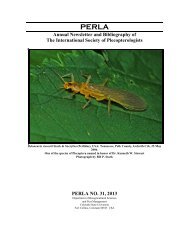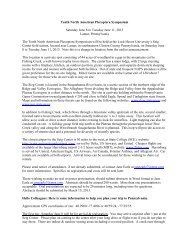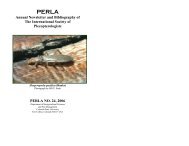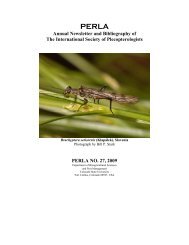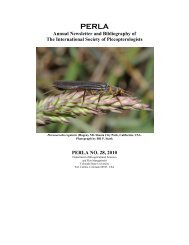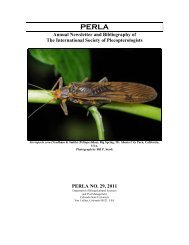Results and DiscussionWe visited only six (Butte, El Dorado, Nevada, Plumas, Tehama, and Yubacounties) of the 58 California counties but collected fifty species of stoneflies, and ofthese 11 or 22% were endemic taxa (Table 1). A group of stonefly species restricted tointermittent streams of the western slope of the Central Sierra Nevada foothills (Storerand Usinger 1963) were especially targeted. These species included Nemoura spinilobaJewett, Oemopteryx vanduzeea (Claassen), Suwallia sierra Baumann and Bottorff,Sweltsa californica (Jewett), Cosumno<strong>perla</strong> hypocrena Szczytko and Bottorff, Iso<strong>perla</strong>acula Jewett, I. adunca Jewett, and I. miwok Bottorff and Szczytko. These small streamsare dry in the summer and autumn (Levick et al. 2008, Szczytko and Bottorff 1987), butsupport a diverse mayfly, stonefly, and caddisfly fauna during the wet period, but areoften not sampled for adult stoneflies. The stoneflies of these unique aquatic systemswere just recently elucidated through the efforts of Richard L. Bottorff (Szczytko andBottorff 1987, Bottorff et al. 1990, Baumann and Bottorff. 1997). In all 14 species couldbe classified as uncommon or rare California stoneflies (Table 1). Paraleuctra projecta(Frison) is a new state record for California (Stark and Kyzar 2000, Stark et al. 2009).AcknowledgmentsJohn Sandberg and his colleagues, Brady Richards, Dan Pickard, and Joe Slusarkfrom the Aquatic Bioassessment Laboratory at California State University, Chico,California enticed us to travel to their backyard in Central California with the promisethat we would indeed be rewarded with many rare and exciting stonefly species, most ofthem in the adult stage. In addition, we took advantage of the fact that we were going tobe in California at this ideal collecting time and asked Richard Bottorff and his brotherLoren to show us some of their choice collecting sites near Placerville. The result wasthat we were abundantly rewarded and were able to collect almost all of the species thatwe targeted and several more that were an added bonus. We thank these colleaguesprofusely because we know that we would not have been nearly as successful withouttheir help. John B. Sandberg is thanked for reviewing the manuscript. Bill Stark isthanked for checking the numbers of species known from California.Literature CitedBallmer, G. 1995. Nation’s richest insect diversity in California. California Agriculture49: 51-52.Baumann, R. W. and R. L. Bottorff. 1997. Two new species of Chloroperlidae(<strong>Plecoptera</strong>) from California. Great Basin Naturalist 57: 343-347.Baumann, R. W. and B. C. Kondratieff. 2009. Studies on Oemopteryx vanduzeea(Claassen, 1937) and a new species in the O. vanduzeea species group(<strong>Plecoptera</strong>: Taeniopterygidae) from the Pacific Northwest. Aquatic Insects 31,Supplement 195-202.Baumann, R. W. and B. C. Kondratieff. 2010. The stonefly genus Lednia in NorthAmerica (<strong>Plecoptera</strong>: Nemouridae). Illiesia 6: 316-328.Bottorff, R. L. S. W. Szczytko, and A. W. Knight. 1990. Descriptions of a new speciesand three incompletely known species of western Nearctic Iso<strong>perla</strong> (<strong>Plecoptera</strong>:Perlodidae). Proceedings of the Entomological Society of Washington 92: 286-303.14
Jewett, S. G., Jr. 1956. <strong>Plecoptera</strong>. Pp. 155-181. In Aquatic Insects of California withkeys to North American genera and California species. R. L. Usinger, ed.University of California Press, Berkeley, California. 508 pp.Jewett, S. G., Jr. 1960. The stoneflies (<strong>Plecoptera</strong>) of California. Bulletin of theCalifornia Insect Survey 6: 1-177.Kondratieff, B. C. and J. J. Lee. 2010. A new species of Paracapnia from California(<strong>Plecoptera</strong>: Capniidae). Illiesia 6: 206-209.Lee, J. J. and R. W. Baumann. 2010. Studies on Sweltsa townesi and a new species,Sweltsa salix, from northern California (<strong>Plecoptera</strong>: Chloroperlidae). Illiesia 6:34-40.Levick, L. R., D. C. Goodrich, M. Hernandez, J. Fonseca, D. Semmens, J. Stromberg, M.Tluczek, R. A. Leidy, M. Scianni, D. P. Guertin, and W. G. Kepner. 2008. Theecological and hydrological significance of ephemeral and intermittent streams inthe arid and semiarid American Southwest. U.S. Environmental ProtectionAgency and USDA/ARS Southwest Watershed Research center, EPA/600/R-08/134, ARS/233046. 116 pp.McElravy, E. P., G. A. Lamberti, and V. H. Resh. 1989. Year-to-year variation in theaquatic macroinvertebrate fauna of a northern California stream. Journal of theNorth American Benthological Society 8: 51-63.Nelson, C. R. and R. W. Baumann. 1987. New winter stoneflies of the genus Capnia withnotes and an annotated checklist of the Capniidae of California (<strong>Plecoptera</strong>:Capniidae). Entomography 5: 485-521.Storer, T. I. and R. L. Usinger. 1963. Sierra Nevada natural history. University ofCalifornia Press, Berkeley, California. 338 pp.Szczytko, S. W. and R. L. Bottorff. 1987. Cosumno<strong>perla</strong> hypocrena, a new genus andspecies of western Nearctic Isoperlinae (<strong>Plecoptera</strong>: Perlodidae). Pan-PacificEntomologist 63: 65-74.Stark, B. P. and J. W. Kyzar. 2000. Systematics of Nearctic Paraleuctra with descriptionof a new genus (<strong>Plecoptera</strong>: Leuctridae). Tijdschrift voor Entomologie 144: 119-135.Stark, B. P., R. W. Baumann and R. E. DeWalt. 2009. Valid stonefly names for NorthAmerica: Updated as of 3/19/2009. <strong>Plecoptera</strong> Society of North America.http://plsa.inhs.uiuc.edu/plecoptera/validnames.aspx, accessed 6 February 2011.Usinger, R. L (ed). 1956. Aquatic Insects of California with keys to North Americangenera and California species. University of California Press, Berkeley,California. 508 pp.Table 1. STONEFLIES COLLECTED APRIL 25-29, 2010 IN NORTH CENTRALCALIFORNIA. * indicates uncommon or rare taxa; m=male(s), f=female(s), and n=nymph(s).NEMOURIDAEMalenka depressa (Banks) Acorn Creek, Skunk Canyon, abv Folsom Lake 70 m 61 fButte Creek, Humboldt Rd, Cherry Hill Cmpg 28 m 14 fspring, Big Chico Creek, Hwy 3213 m 14 fGreenwood Creek, Hwy 49, nr Coloma1 m 2 fGurnsey Creek, Hwy 36, Gurnsey Creek Cmpg 1 m*Nemoura spiniloba Campbell Creek, North Table Mountain, Cherokee Rd 30 m 28 f15
- Page 1: PERLAAnnual Newsletter and Bibliogr
- Page 4 and 5: PERLA SUBSCRIPTION POLICYDues for m
- Page 6 and 7: A. Popijač & I. Sivec. Recent find
- Page 8 and 9: 2011 XIIITH INTERNATIONAL CONFERENC
- Page 10 and 11: TENTH NORTH AMERICAN PLECOPTERA SYM
- Page 12 and 13: Fig. 1. Number of specimen records
- Page 16 and 17: (Jewett) stream, W Martinez Creek,
- Page 18 and 19: *Isoperla acula Jewett Blue Tent Cr
- Page 20 and 21: Baumann, R. W. and B. C. Kondratief
- Page 22 and 23: and their role in vibrational commu
- Page 24 and 25: Hamilton, B. T., S. E. Moore, T. B.
- Page 26 and 27: Krno, I. 2010. A new model estimati
- Page 28 and 29: Montz, G. R., J. Hirsch, R. Rezanka
- Page 30 and 31: Rebora, M., D. Murányi, S. Piersan
- Page 32 and 33: Stark, B. P. and I. Sivec. 2010. Sy
- Page 34 and 35: enthic macroinvertebrates for three
- Page 36 and 37: Standing CommitteeInternational Soc




